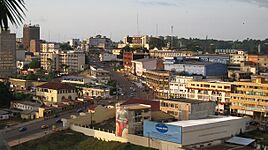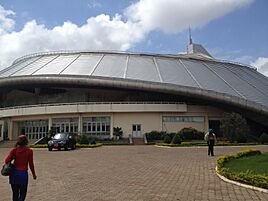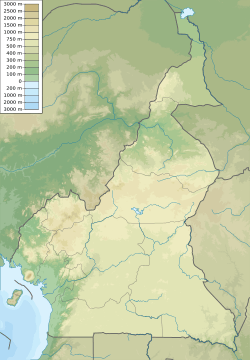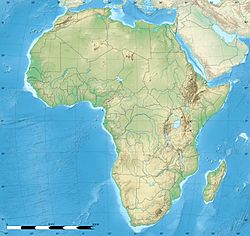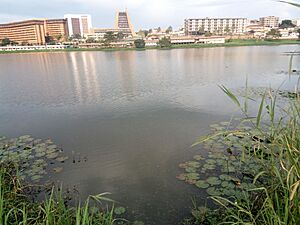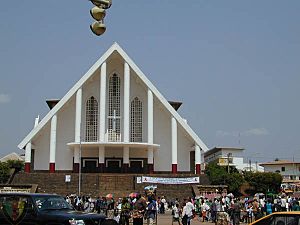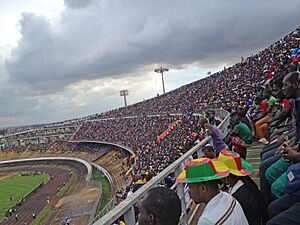Yaoundé facts for kids
Quick facts for kids
Yaoundé
|
||
|---|---|---|
|
Yaoundé skyline
Caisse Nationale de Prévoyance Sociale building
Ministère de l'éducation headquarter
Bank of Central African States building
Independence square
Immeuble de la Mort
Yaoundé Sports Palace
Musée National du Cameroun
Centre Pasteur
|
||
|
||
| Nickname(s):
La Ville aux Sept Collines
|
||
| Country | ||
| Region | Centre | |
| Department | Mfoundi | |
| Area | ||
| • Capital city | 180 km2 (70 sq mi) | |
| Elevation | 726 m (2,382 ft) | |
| Population
(2015 Projection)
|
||
| • Capital city | 2,765,600 | |
| • Density | 15,400/km2 (39,800/sq mi) | |
| • Metro | 4,681,768 | |
| Time zone | UTC+01:00 (West Africa Time) | |
| • Summer (DST) | (Not Observed) | |
Yaoundé is the capital city of Cameroon. It is the second-largest city in the country, with over 2.8 million people. Only the port city of Douala is larger. Yaoundé is located in the Centre Region and sits about 750 meters (2,500 feet) above sea level.
The city began as a trading post called Epsumb or Jeundo in 1887. German explorers set it up between the Nyong and Sanaga rivers. It was a base for trading rubber and ivory. A military base was added in 1895, which helped with further colonization.
After Germany lost World War I, France took control of eastern Cameroon. Yaoundé was chosen as the capital of the colony in 1922. Even though Douala was a more important city for a long time, Yaoundé grew quickly. It remained the seat of government when the Republic of Cameroon became independent in 1960.
Today, Yaoundé's economy mostly depends on its role as the capital. This means it has many government offices and diplomatic services. Major industries in the city include tobacco, dairy products, beer, clay, glass items, and timber. The city also has many impressive buildings and monuments, like the Presidential Palace.
Contents
History of Yaoundé
The first people in Cameroon were likely the Bakas, also known as pygmies. They still live in the forests of the southern and eastern parts of the country. Later, Bantu-speaking groups from the Cameroonian highlands moved into the area. In the late 1700s and early 1800s, the Fulani, who are a pastoral Islamic group, took over much of northern Cameroon.
The trading post of Epsumb or Jeundo was founded around 1887 by German explorers Lt. Richard Kund and Hans Tappenbeck. They made an agreement with the local chiefs of Ela Esono. From 1889 to 1895, the German botanist Georg August Zenker used it as a research station. He named it Jaunde after the local Yaunde or Ewondo people. This settlement was a base for trading rubber and ivory. People bought these from the local people in exchange for imported clothing and iron. It was also known as Yaunde Station.
In 1895, Major Dominik set up a military base there. This allowed a religious mission and school to be built nearby in Mvolyé, which is now a part of the city.
During World War I, Belgian troops from the Belgian Congo took over Jaunde. After Germany's defeat, France was given control of eastern Cameroon by the League of Nations. Yaoundé was then chosen to be the capital of the colony in 1922.
Douala was the main city for a long time. However, Yaoundé grew very fast after 1957. This was partly due to problems with cocoa farming and unrest along the coast. Yaoundé continued to be the government center when the Republic of Cameroon became independent.
Economy and Industries
Yaoundé's economy is mostly based on its role as the capital. This means it has many government jobs and diplomatic services. Because of this, Yaoundé generally has a better standard of living and is safer than other parts of Cameroon.
Key industries in Yaoundé include making tobacco products, dairy products, beer, and items from clay and glass. It is also a center for distributing goods like coffee, cocoa, copra, sugar cane, and rubber.
Many people in the city also grow food for themselves. It is thought that there are "50,000 pigs and over a million chickens" in the city.
In 2010, Yaoundé started a project to reduce floods. This plan aimed to stop the "severe floods [that] disrupted the city 15 to 20 times a year." These floods affected as many as 100,000 people. After four years, the number of floods went down from fifteen to three times a year. Also, cases of water-borne diseases like typhoid and malaria were cut by almost half. City officials are still working to improve the city's sanitation.
City Landmarks and Architecture
The city center is where you will find government offices, some hotels, and the main market. The Bastos area is home to foreign embassies and many people from other countries. The presidential palace is located in the Etoudi district.
Other important places in Yaoundé include:
- The Reunification Monument, which celebrates Cameroon becoming one country.
- The Sport Palace (Palais des Sports), a large sports arena.
- The Palais des Congrès, a big convention center.
There is also a small zoo in the Mvog-Betsi neighborhood. Yaoundé has a variety of pubs, nightclubs, and restaurants. Outside the city, there is an organization called Ape Action Africa. It helps rescue and care for Great Apes that are in danger because of illegal hunting and deforestation.
Culture and Museums
Yaoundé is home to several cultural sites and museums:
- The Cameroon Art Museum, which is in an old Benedictine monastery.
- The Cameroon National Museum, located in the former presidential palace.
- The Blackitude Museum.
- The Afhemi Museum.
- The Yaoundé Municipal Lake.
- The Mvog-Betsi Zoo-Botanic Park.
- The Congress Centre in Tsinga.
Places of Worship
Most of the places of worship in Yaoundé are Christian churches. These include the Roman Catholic Archdiocese of Yaoundé (Catholic Church), Christian Missionary Fellowship International, and various Protestant churches like the Evangelical Church of Cameroon and the Presbyterian Church in Cameroon. There are also Muslim mosques in the city.
Climate in Yaoundé
Yaoundé has a tropical wet and dry climate. This means it has warm temperatures all year round. Because of its altitude, the temperatures are not as hot as you might expect for a city near the equator.
The city has a long wet season that lasts for about ten months, from March to November. There is a slight drop in rain during July, making it seem like there are two rainy seasons. This is because the city is just a little north of the equator.
| Climate data for Yaoundé | |||||||||||||
|---|---|---|---|---|---|---|---|---|---|---|---|---|---|
| Month | Jan | Feb | Mar | Apr | May | Jun | Jul | Aug | Sep | Oct | Nov | Dec | Year |
| Record high °C (°F) | 33 (91) |
33 (91) |
33 (91) |
36 (97) |
34 (93) |
32 (90) |
31 (88) |
34 (93) |
31 (88) |
33 (91) |
32 (90) |
32 (90) |
36 (97) |
| Mean daily maximum °C (°F) | 29.6 (85.3) |
31.0 (87.8) |
30.4 (86.7) |
29.6 (85.3) |
28.8 (83.8) |
27.7 (81.9) |
26.5 (79.7) |
26.5 (79.7) |
27.5 (81.5) |
27.8 (82.0) |
28.1 (82.6) |
28.5 (83.3) |
28.5 (83.3) |
| Daily mean °C (°F) | 24.6 (76.3) |
25.7 (78.3) |
25.4 (77.7) |
25.0 (77.0) |
24.5 (76.1) |
23.8 (74.8) |
23.2 (73.8) |
22.9 (73.2) |
23.4 (74.1) |
23.5 (74.3) |
23.9 (75.0) |
24.0 (75.2) |
24.2 (75.6) |
| Mean daily minimum °C (°F) | 19.6 (67.3) |
20.3 (68.5) |
20.3 (68.5) |
20.3 (68.5) |
20.2 (68.4) |
19.9 (67.8) |
19.9 (67.8) |
19.3 (66.7) |
19.3 (66.7) |
19.2 (66.6) |
19.6 (67.3) |
19.5 (67.1) |
19.8 (67.6) |
| Record low °C (°F) | 14 (57) |
15 (59) |
16 (61) |
15 (59) |
16 (61) |
15 (59) |
16 (61) |
16 (61) |
15 (59) |
15 (59) |
17 (63) |
16 (61) |
14 (57) |
| Average precipitation mm (inches) | 19.0 (0.75) |
42.8 (1.69) |
124.9 (4.92) |
171.3 (6.74) |
199.3 (7.85) |
157.1 (6.19) |
74.2 (2.92) |
113.7 (4.48) |
232.3 (9.15) |
293.6 (11.56) |
94.3 (3.71) |
18.6 (0.73) |
1,541.1 (60.69) |
| Average precipitation days (≥ 0.1 mm) | 3 | 4 | 12 | 14 | 17 | 14 | 11 | 12 | 20 | 23 | 11 | 3 | 144 |
| Average relative humidity (%) | 79.5 | 79.5 | 81.0 | 82.0 | 84.0 | 85.0 | 85.5 | 86.0 | 85.5 | 85.0 | 82.0 | 79.0 | 82.8 |
| Mean monthly sunshine hours | 172.0 | 179.0 | 169.9 | 164.5 | 166.2 | 126.0 | 96.1 | 86.2 | 102.4 | 130.2 | 167.1 | 181.4 | 1,741 |
| Source 1: World Meteorological Organization NOAA (sun 1961–1990) | |||||||||||||
| Source 2: BBC Weather | |||||||||||||
Transportation in Yaoundé
Two major trans-African roads pass through Yaoundé:
Many bus companies operate from the city, especially in the Nsam and Mvan areas. Buses run frequently between Yaoundé and Douala. The trip by road usually takes about 3 hours. Traffic in Yaoundé can be heavy during weekdays but is much lighter on weekends. The city has made good progress in building and improving its roads.
Yaoundé Nsimalen International Airport is the main airport for civilian flights. A nearby airport, Yaoundé Airport, is used by the military.
Train lines connect Yaoundé to the port city of Douala in the west and to N'Gaoundéré in the north.
Education in Yaoundé
Cameroon is a bilingual country, meaning both English and French are official languages. Because of this, Yaoundé has schools that follow both the French and English education systems. In French schools, students earn a Baccalauréat to go to university. In English schools, they earn a GCE Advanced level.
There are also American schools in Yaoundé, such as the American School of Yaounde (ASOY) and Rain Forest International School (RFIS). There is also a Turkish school called The Amity College/School.
Yaoundé is home to several universities, including the University of Yaoundé II, the Protestant University of Central Africa (UPAC), and the Catholic University of Central Africa (UCAC). Many of the country's special training schools are also in Yaoundé. These include schools for teachers, engineers, doctors, nurses, and diplomats.
Healthcare Services
The largest hospital in Yaoundé is the Central Hospital of Yaoundé (Hôpital Central de Yaoundé), which has 650 beds. The Yaoundé General Hospital (Hôpital Général de Yaoundé – HGY) was built in 1985 and has 302 beds. Other hospitals include the Yaoundé Gynaecology, Obstetrics and Pediatrics Hospital (Hôpital Gynéco-Obstétrique et Pédiatrique de Yaoundé – HGOPY) and the University Hospital Center of Yaoundé (Centre Hospitalier Universitaire de Yaoundé – CHU).
Sports in Yaoundé
The national football team sometimes plays its home games at the Ahmadou Ahidjo stadium. Football clubs like Canon Yaoundé, Impôts FC, and Tonnerre Yaoundé are all based in the city. The Grand Prix Chantal Biya, a men's road bicycle racing event, also starts and finishes in Yaoundé.
Yaoundé is also where the National Institute of Youth and Sport (INJS) is located. This school trains government workers who will be in charge of sports across the country.
Many famous athletes come from Yaoundé. These include Joel Embiid, a basketball player for the Philadelphia 76ers, and Luc Mbah a Moute, a former basketball player for the Los Angeles Clippers. Footballers like Samuel Umtiti (who plays for the French national team and FC Barcelona), Breel Embolo (for AS Monaco FC), and Vincent Aboubakar (for Porto) are also from Yaoundé.
Notable People from Yaoundé
- Joel Embiid, professional basketball player
- Breel Embolo, Swiss professional footballer
- Francis Ngannou, UFC Heavyweight Champion
- Samuel Umtiti, French professional footballer
- Youssoufa Moukoko, German professional footballer
Images for kids
See also
 In Spanish: Yaundé para niños
In Spanish: Yaundé para niños


